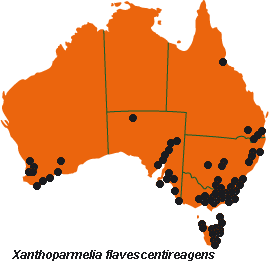



Australian Biological Resources Study
| Checklist of the Lichens of Australia and its Island Territories | ||
| Introduction | A–D | E–O | P–R | S–Z | Oceanic Islands | References | ||
| Xanthoparmelia flavescentireagens (Gyeln.) D.J.Galloway | ||
| New Zealand J. Bot. 18: 533 (1980); Parmelia flavescentireagens Gyeln., Repert. Spec. Nov. Regni. Veg. 36: 154 (1934). T: Booroomba Rocks, [A.C.T.], Feb. 1906, G.H.Barker s.n.; holo: BP. *****[Parmelia conspersa var. austroafricana auct. non (Stirt.) Stizenb. [= Xanthoparmelia austroafricana (Stirt.) Hale]: W.A.Weber & C.M.Wetmore, Beih. Nova Hedwigia 41: 70 (1972)] | ||
| Thallus foliose, loosely to moderately adnate, to 15 cm wide. Lobes very variable, flat or weakly convolute, subirregular with rotund apices to sublinear, subirregularly branched, constricted, 1.5–2.5 (–10) mm wide, without lobules; apices appressed; laciniae imbricate, sometimes building up thallus into a thick mat, sublinear-elongate, subdichotomously branched, 0.8–1.5 mm wide. Upper surface pale yellow to yellow-green, darkening with age, slightly convex, shiny, emaculate, smooth, lacking soredia and isidia; lobes often with black margins. Medulla white. Lower surface flat to weakly canaliculate, pale ivory to brown, darker towards lobe apices where it is commonly blackened; rhizines moderately dense, often grouped subapically, slender, short, concolorous. Apothecia sessile, to 10 mm wide; disc deeply concave, pale brown; thalline exciple smooth, thin, crenulate, deeply incised. Ascospores 11–14 × 5–7 µm. Pycnidia common. Conidia bifusiform, 6–7 × 0.5 µm. CHEMISTRY: cortex K-, UV-; medulla K-, C-, KC+ rose, P-; containing usnic acid, loxodin, norlobaridone, ±constipatic acid, ±protoconstipatic acid, ±scabrosin 4,4'-diacetate, ±scabrosin 4-acetate 4'-butyrate, ±scabrosin 4-acetate 4'-hexanoate, ±scabrosin 4,4'-dibutyrate, ±conloxodin and ±conorlobaridone. |  |
|
| Ubiquitous and variable. Found from sea level to 2000 m throughout southern and eastern Australia (W.A., S.A., Qld, N.S.W., A.C.T., Vic. and Tas.); also on Lord Howe Is. and on both islands of New Zealand. Grows on rock, pebbles, soil and rarely dead wood. | ||
| Elix (1994z) | ||
| Checklist Index |
| Introduction | A–D | E–O | P–R | S–Z | Oceanic Islands | References |
This work is copyright. Apart from any use as permitted under the Copyright Act 1968, no part may be reproduced by any process without prior written permission from Australian Biological Resources Study. Requests and inquiries concerning reproduction and rights should be addressed in the first instance to Dr P. McCarthy. These pages may not be displayed on, or downloaded to, any other server without the express permission of ABRS.